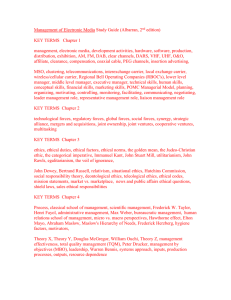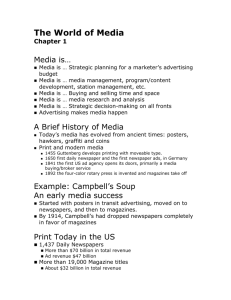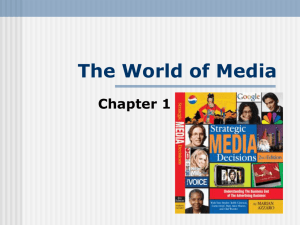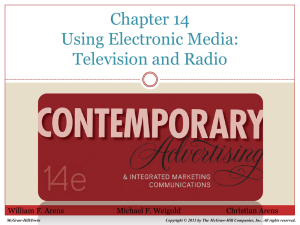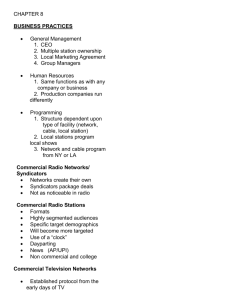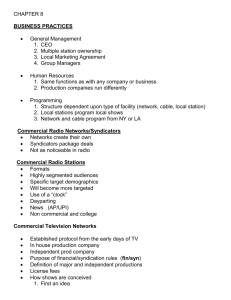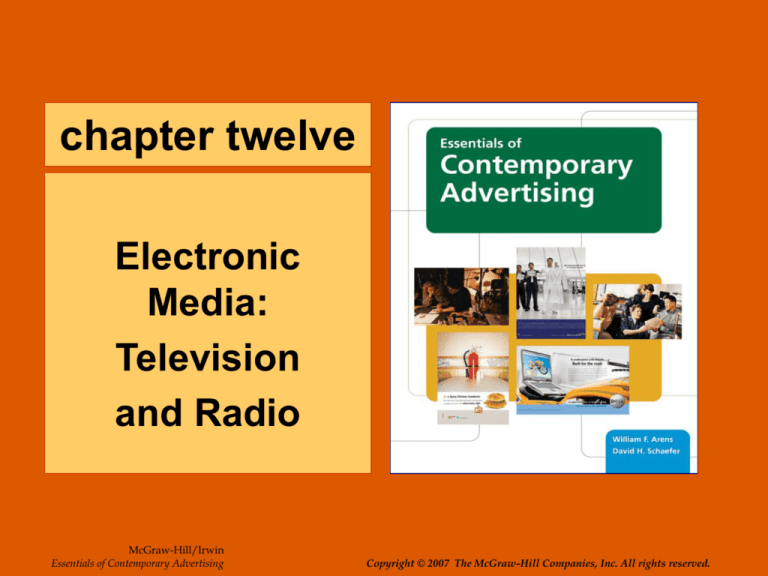
chapter twelve
Electronic
Media:
Television
and Radio
McGraw-Hill/Irwin
Essentials of Contemporary Advertising
Copyright © 2007 The McGraw-Hill Companies, Inc. All rights reserved.
Objectives_1
Describe the advantages and drawbacks of
broadcast television as an advertising medium
Discuss the advantages and drawbacks of
cable television as an advertising medium and
explain how it differs from broadcast television
Explain the process of buying cable and
broadcast TV time
Evaluate the different types of television
advertising available
12-2
Objectives_2
Describe the process of TV audience
measurement
Discuss the main factors to consider
when buying television time
Analyze the pros and cons of using
radio in the media mix
Explain the major factors to consider
when buying radio time
12-3
The Electronic Media Landscape
in the U.S.
1,685 local commercial TV stations
10,000+ local radio stations
4 major TV networks
10,000+ local cable systems
12-4
Top Cable TV Networks
Discovery Channel
ESPN
Cable News
Network (CNN)
Turner Network
Television (TNT)
USA Network
Nickelodeon
TBS Superstation
Spike TV
Arts & Entertainment
(A&E)
Lifetime
ESPN2
The Weather
Channel
12-5
Cable Facts
Cable reaches 85% of TV households
Most consumers receive more than 100
channels, but watch only 15-19
channels
Cable households watch more hours of
TV than non-cable households
Most channels are privately owned
Cable fees make up about 1/3 of cable
revenues
12-6
Broadcast TV Facts
Heaviest viewers are middle-income,
high-school-educated
Average U.S. home viewers watch 8
hours of TV (includes cable and
VCR/DVR) per day
Older women watch the most TV
12-7
Pros of Broadcast
TV Advertising
Mass coverage
Relatively low cost
per viewer
Some selectivity
Persuasion power
Impact
Creativity
Prestige
Social dominance
12-8
Power of Television
12-9
Cons of Broadcast
TV Advertising
High production
cost
High airtime cost
Long lead times
Limited
selectivity
Audience
fragmentation
Brevity
Clutter
Zipping and
zapping
12-10
What forms of advertising will replace
traditional commercials?
Sponsorship of TV programs and televised
sporting events
Product placements
Interactive advertising during programs
Ads embedded in VOD programs
Ads within the DVR main menu
Ads within VOD main menu
Celebrity endorsement deals
12-11
Pros and Cons
of Cable TV Advertising
Pros
Selectivity
Audience
demographics
Low cost
Flexibility
Testability
Cons
Limited reach
Fragmentation
Quality
Zipping and
zapping
12-12
Buying TV Time
Sponsoring TV programs
Participating in programs
Purchasing spot announcements
Purchasing spots from syndicators
Running program-length ads
12-13
Participation:
Most Expensive Shows
American Idol
Desperate
Housewives
CSI
Grey’s Anatomy
ER
Extreme Makeover
Survivor
The Apprentice
The Apprentice,
Martha Stewart
Two and a Half Men
12-14
Syndication
Largest source of programming
Forms
– Off-network
– First-run
– Barter
12-15
Exhibit 12-7a Network Approach
12-16
Exhibit 12-7b Syndication Approach
12-17
Growth in Program-Length Ads
Consumers pay attention and can
respond immediately
PLAs combine the power of advertising,
direct response, and sales promotion
PLAs allow for product demonstration
and brand differentiation
Results are measurable and
accountable
12-18
TV Audience Measurement
Nielsen Media Research
– Nielsen Television Index (NTI)
• People meters in 55 markets
• Diaries in 210 local markets during
sweeps
Simmons Market Research Bureau
Mediamark Research
12-19
Audience Measurements
TV Households
(TVHH)
Audience
Composition
Households
using TV
(HUT)
Total
Audience
Program
Rating
Audience
Share
12-20
TV Dayparts
Daytime: 9:00 a.m.-4:00 p.m.
Early fringe: 4:00-5:30 p.m.
Early news: 5:00 or 5:30-7:30 p.m.
Prime access: 7:30-8:00 p.m.
Prime: 8:00-11:00 p.m.
Late news: 11:00-1130 p.m.
Late night: 11:30 p.m.-1:00 a.m.
12-21
Buying Television Time
Determine available programs and costs
Analyze program efficiencies
Negotiate prices with station reps
Determine number and frequency of viewers
Sign broadcast contracts
Review affidavits of performance
12-22
Program Efficiency
Cost Per Point (CPP) = Cost/Rating
Cost Per Thousand (CPM) =
Cost/Thousands of People
Cost Per Thousand-Target Market
(CPM-TM) =Cost/Thousands of People
in Target Audience
12-23
Radio Facts
95.4% of the U.S. population listens to
the radio at least once in an average
week
The average American listens to the
radio more than 3 hours per day
The CPM for radio has risen less than
for any other major medium
12-24
Pros of Radio Advertising
Frequent access to
large audience
Selectivity
Cost efficiency
Visualization
Timeliness
Immediacy
Local relevance
Creative flexibility
Image transference
Enhanced
interactive aspects
12-25
Cons of Radio Advertising
Limitations of sound
Segmented
audiences
Short-lived/ halfheard
Clutter
No visual
component
Threats of satellite
radio and personal
music systems
12-26
Programming Formats
Country
News/Talk
Religious
Oldies
Adult
contemporary
Classic rock
Spanish
Top 40
Soft adult
contemporary
Easy listening
Rock
Alternative rock
Jazz
Classical
12-27
Types of Radio Advertising
Network
Spot
Local
12-28
Radio Dayparts
Morning drive: 6:00-10:00 a.m.
Daytime: 10:00 a.m.-3:00 p.m.
Afternoon/Evening drive: 3:00 p.m.-7:00
p.m.
Nighttime: 7:00 p.m.-12:00 a.m.
All night: 12:00-6:00 a.m.
12-29
Radio Terminology
Run of station
(ROS)
Total audience
plan (TAP)
Average quarterhour audience
(AQH persons)
Average quarterhour rating
Average quarterhour share
Gross impressions
Gross rating points
Cume persons
Cume rating
12-30
Steps in Preparing a Radio
Schedule
Identify stations with greatest cume of target audience
Identify station formats with best access to prospects
Determine best dayparts
Construct a schedule using rate cards to guide budget
Evaluate buy in terms of audience delivery
Determine CPM-TM
Negotiate and place buy
12-31
Key Terms_1
Affidavit of
performance
Audience
composition
Audience share
Avails
Average quarterhour audience
Average quarterhour rating
Average quarterhour share
Barter syndication
Broadcast TV
Cable TV
Cost per rating point
Cost per thousand
Cume persons
Cume rating
12-32
Key Terms_2
Daypart mix
Designated market
area
Digital video
recorder
Drive time
First-run syndication
Gross impressions
Gross rating points
Households using
TV
Imagery transfer
Infomercial
Inventory
Local time
Makegoods
Networks
Off-network
syndication
12-33
Key Terms_3
Participation
Preemption rate
Prime time
Program-length
advertisement
Program rating
Programming format
Rating service
Run-of-station
Sponsorship
Spot announcement
Spot radio
Sweeps
Total audience
Total audience plan
TV households
12-34

